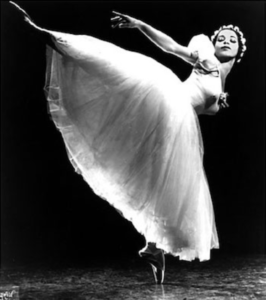Raven Wilkinson and Janet Collins

Raven Wilkinson, AAREG
As the first African American woman to be contracted full-time to dance with a major ballet company (the Ballet Russe de Monte Carlo of New York City), Raven Wilkinson created tremendous impacts in the dance community and for black dancers.
Janet Collins was no different and largely paved the way for Raven Wilkinson. In the 1930s, Janet Collins auditioned for the Ballet Russe de Monte Carlo but was told that, to be accepted, she would have to perform in whiteface. Janet Collins painstakingly declined; she was unwilling to sacrifice her identity for an opportunity. Janet Collins continued to dance, and in the early 1950s, inspired then teenage Raven Wilkinson to pursue ballet full time. Raven Wilkinson
Two decades after Janet Collins was offered a position with the Ballet Russe de Monte Carlo, Raven Wilkinson was presented with the same dilemma: to dance in white makeup and conceal her identity or to not dance at all.
 Wilkinson accepted the position and became the first black ballerina in the Ballet Russe de Monte Carlo and achieved lead roles in Giselle and The Nutcracker. Around this same time, Janet Collins became the first premier ballerina in the Metropolitan Opera Ballet, achieved leading roles, and encouraged other companies to begin integrating.
Wilkinson accepted the position and became the first black ballerina in the Ballet Russe de Monte Carlo and achieved lead roles in Giselle and The Nutcracker. Around this same time, Janet Collins became the first premier ballerina in the Metropolitan Opera Ballet, achieved leading roles, and encouraged other companies to begin integrating.
However, Wilkinson’s successes came with tremendous barriers and limitations due to racism. Wilkinson was required to be white passing and wear lighter powder so that audiences would assume she was white. On tours in the south, Wilkinson was confronted with tremendous forms of segregation and bigotry. When an elevator operator recognized her to be African American at a hotel with her dance company, she was forced to leave and stay in another hotel. In 1954 after a school segregation court decision was made and incited an increase in racially motivated violence, members of the KKK stormed the stage during a performance in Montgomery, Alabama, demanding to know which of the ballerinas was black. This, in combination with bomb threats and boycotts, prompted the Ballet Russe de Monte Carlo to cancel their tours in the south and for Wilkinson to retire her role from the company out of concerns for her safety.
Both Collins and Wilkinson shattered glass ceilings in the dance community and defied discriminatory limitations. Similar to how Janet Collins’ performance and presence in ballet provided representation and inspiration for Raven Wilkinson, Raven Wilkinson’s achievements and advancements in ballet have served as an inspiration for many, including Misty Copeland, the first African American Female Principal Dancer with the American Ballet Theater.
Sources:
https://www.blackpast.org/african-american-history/wilkinson-anne-raven-1935/
https://daily.jstor.org/the-history-of-african-american-casting-in-ballet/
https://aaregistry.org/story/raven-wilkinson-ballet-pioneer/
More about Raven Wilkinson

